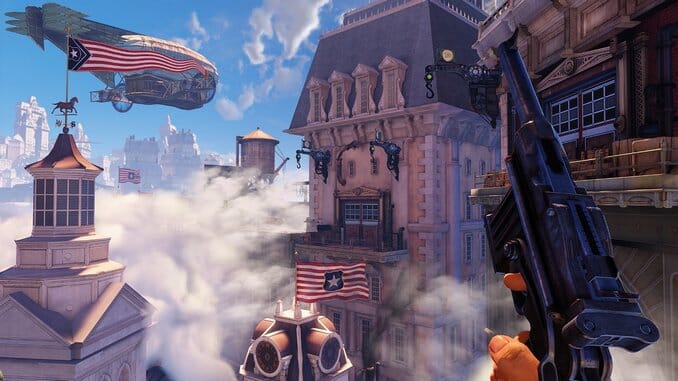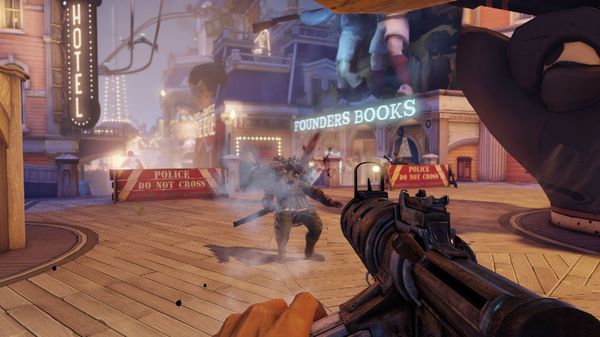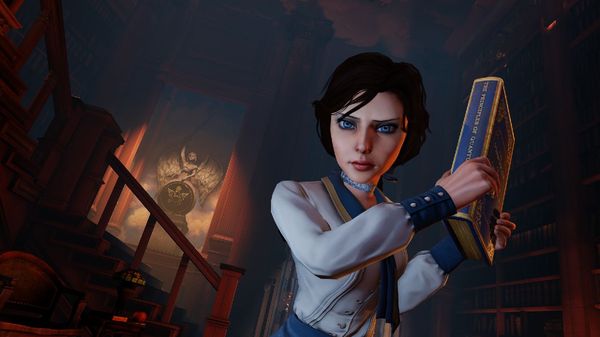
There are no specific spoilers below, but Paste can’t guarantee that you won’t learn something about Bioshock Infinite that you don’t want to know. Tread carefully if you’re afraid of any spoilers whatsoever, no matter how general.
Godard said all you need for a movie is a girl and a gun. All you need for a Bioshock game is a girl, a gun and an entirely impractical city. (Or, in the case of the first Bioshock, a whole team of girls whose spinal fluid you can systematically drain out one by one, if you choose.) Oh, and there should also be some kind of magical pseudoscience that lets you shoot stuff out of your left hand, and maybe one or two meta plot twists that offer fairly obvious commentary on the nature of games.
Yes, we can now refer to “a Bioshock game” as its own little gun-happy, girl-crazy subgenre of interactive storytelling. Before Infinite Bioshock wasn’t a series but a single highly praised game (and one unfairly dismissed sequel). That game was a bit deeper and far cleverer than most first-person shooters, with a rich setting and inspired narrative tricks that confounded expectations. Infinite revisits what made Bioshock feel fresh and exciting, stripping away the novelty and codifying it into a template. Bioshock 2 might’ve revisited the first game’s setting, but Infinite expands on the first game’s themes, to diminishing returns.
That’s not to say that Bioshock Infinite is not a good game. It’s not even remotely bad in the classical sense. It is certainly competent, and you probably won’t have to force yourself to finish it. If you’re like me you will get swept up by a sense of urgency, searching for answers to its secrets and anxiously awaiting the surprises you know are coming. When you are not playing Bioshock Infinite you will probably think about playing Bioshock Infinite, during work or school or whatever other previously scheduled engagements might force you out of the house. At game’s end, though, you might feel a vague sense of dissatisfaction, both at how the story transpires and at the amount of busywork on the way to that end.
At first Infinite floats along splendidly. It builds tremendous goodwill simply by tackling a time period and subject matter that few games would ever consider. Infinite introduces a society where certain mainstream political and social beliefs from the turn-of-the-(20th)-century are allowed to persist and intensify without any sort of progressive counterpoint. The cloud city of Columbia serves as an ambassador for the virtue and ideals of an America whose self-image diverges greatly from reality. Columbia exalts America’s freedom and morality at a time when the establishment doesn’t even try to hide its contempt and hatred for those from other races or socioeconomic groups. If you aren’t a well-off white man of Northern European stock, you’re pretty much out of luck in the America that created Columbia. Infinite is rooted in the Gilded Age but these timeless themes of racism, classism and religious absolutism are obviously dripping with contemporary resonance, and for much of Infinite that alone is enough to keep you enthralled.
Lead writer Ken Levine and his co-writers are adept with dialogue and colorful side characters. It’s a bit weird that characters would leave extremely private and revealing audio recordings of themselves scattered about throughout the city, but it’s an effective and non-obtrusive way to build backstory, and the writing and voice-acting are largely excellent. Our hero, Booker DeWitt, is more developed than Bioshock’s Jack, and there’s a delicacy to his interactions with the heroine Elizabeth that makes a genuine emotional response seem possible. Elizabeth isn’t just a glorified version of the “girl in your ear” trope, but a central character that accompanies and assists you throughout the vast majority of the game.
Infinite also reinforces Bioshock’s greatest revelation: Nobody’s better at atmosphere and art design than Irrational Games. From the bright and idyllic town squares, neocolonial architecture and massive statuary of Columbia’s wealthier precincts, to the decaying slums of the impoverished industrial zone Finkton, Infinite introduces a glorious and instantly iconic setting, and eventually asks you to kill almost every living thing within. There’s a scene set within amusement park recreations of the Boxer Rebellion and the massacre at Wounded Knee that ranks among the most visually striking and immersive moments I’ve ever seen in a game. Irrational understands the power of the moving image better than perhaps any other big-budget game studio.
Columbia is gorgeous, but it’s no Rapture. In Rapture you always felt the pressure of all that water above you. Despite Infinite’s preponderance of blimps and balloons and the ability to hurl enemies to their doom, you’ll occasionally forget that these shoot-outs are occurring at 15,000 feet. Also the turn-of-the-century aesthetic might be unique for a first-person shooter, but it looms larger both in real life and in pop culture than Bioshock’s art deco pizzazz. Columbia cuts a sharp figure, with its brass eagles and crisp red, white and blue flags flapping in the wind, but it isn’t as entrancing as Rapture’s sleek curves or its warm neon glowing through the murk.
The biggest problem with Columbia is that it never really feels alive, even at the start, when it’s still full of normal people peacefully living their lives. These citizens feel stiffer and more robotic than the Founding Father robots that come to life and try to kill you like the automatons from Itchy and Scratchy Land. Later, when you descend into Finkton, you encounter human suffering ripped straight from Jacob Riis photos, with broken adults and starving children begging for hand-outs while singing sad gospel blues. They repeat their canned motions in perpetuity like the prisoners reaching for the dog’s keys in the Pirates of the Caribbean ride.
Columbia springs most fully to life when you’re killing things. I appreciate the slower and more methodical pace of Infinite’s combat, which, like Bioshock, consists of juggling between a variety of firearms and several different magical abilities that have a drastic impact upon the enemy. Whipping brigands into the air with a vigor and then shooting them down with a shotgun like a clay pigeon is as fun the hundredth time as it is the first, and uncovering the most potent combinations of vigors is one of the game’s more useful and understated quests. Battles quickly grow repetitive, though, with the same handful of enemy types constantly popping up. Platoons of gunmen wield variations on your own weapons, and special enemies have clear analogues in the original Bioshock. Some opponents can teleport in a burst of crow feathers like the cultists from the original, while the lumbering cyborg Handymen are a less frightening and less poignant take on the Big Daddy. Battles too often take place in large open areas, and whenever you first enter a spacious lobby or town square you know a battle’s a-brewing. The pacing is deliberate but it quickly becomes as predictable as the non-stop rush of a Call of Duty.
It’s also very difficult to die when you have Elizabeth by your side. She’s a one-woman support unit, combining the tasks of both a medic and an engineer. She doesn’t fight, but she does toss out ammo or health packs when needed, and can create weapon installations and defensive cover on certain spots on the map. I died a few times during one particular fight, but for the most part Elizabeth keeps Booker alive during most battles.
Story-wise Elizabeth is crucial to Infinite, and Levine told me that one of his main goals with the game was for players to “make an emotional connection” with her. Liz is a nice girl (there might be a bit too much Disney princess / Manic Pixie Dream Girl in her), and voice-actor Courtnee Draper gives a nicely naturalistic performance, but it’s hard to get too misty-eyed over a character that’s essentially part plot device and part walking loot drop. If special feelings for Elizabeth are the key to Infinite, then Irrational didn’t quite pull off what it was trying to.
You’ll want to connect to Elizabeth, though. You’ll want to see the end of her story, and what debts could be so significant that Booker would go to such extreme lengths to rescue her. You’ll trudge through shoot-outs well after they grow tiresome to learn the history of Columbia and its cultic leader, the self-proclaimed prophet Zachary Hale Comstock (who pales in comparison to Andrew Ryan). All those threads tie together into an awkward sci-fi tale that disappoints more with every revelation, embracing some of the most annoying pitfalls of time travel stories, and all wrapped around a metaphor for a self-evident fact about the very nature of videogames that’s presented as some kind of grand “a-ha!” moment. You’ll play forward for that special spark you expect from a Bioshock game, only to realize that that part of the template isn’t so easy to recreate.
Last week on Twitter I described Bioshock Infinite as a “shooting spree at Disney’s Main Street while Zooey Deschanel throws stuff at you”. I was maybe halfway through Infinite when I wrote that, and now that I’ve finished the game I can admit that there’s far more here than that bad joke indicates. There’s too much more. Bioshock Infinite is a game where the story comes first, and that story slowly contorts itself into a convoluted mess.
Bioshock Infinite was developed by Irrational Games and published by 2K Games. Our review is based on the Xbox 360 version. It is also available for the PlayStation 3 and PC.
Garrett Martin edits Paste’s games section and reviews games for the Boston Herald and elsewhere. You can follow him on Twitter, if you’d like.

